Students should refer to Previous Year Questions ICSE Class 10 Physics Current Electricity with solutions that have been prepared by expert teachers of ICSE Class 10 Physics. These questions and solutions are based on past year papers that have come in examinations of ICSE Class 10. Students should understand the type of questions asked and the solutions provided. Also refer to ICSE Class 10 Physics Solutions
ICSE Class 10 Physics Current Electricity Last Year Questions
Students should learn the important questions and answers given below for Chapter Current Electricity in Physics for ICSE Class 10. These board questions are expected to come in the upcoming exams. Students of ICSE Class 10th should go through the board exams questions and answers for ICSE Class 10 Physics which will help them to get more marks in exams.
Board Exam Questions Current Electricity ICSE Class 10 Physics
Previous Year Questions ICSE Class 10 Physics Current Electricity
Short Answer Type Questions I
Question: What are the factors on which resistance of a conductor depends?
Answer: The resistance of a conductor depends on the following factors
1. Length of the wire (l). Resistance is directly proportional to the length of wire, i.e., R ∝ l.
Area of cross-section Resistance is inversely proportional to the area of cross-section i.e., R ∝ 1/A.
3. Nature of wire i.e., material of which the wire is made of.
Question: Define specific resistance of a material. State its S.I. unit.
Sol. Specific resistance of a material is the resistance of a material of unit length and unit area of crosssection. Its SI unit is ohm meter.
Question: The V-I graph for a series combination and for a parallel combination of two resistor is shown
in the figure below. Which of the two A or B, represents the parallel combination? Give a reason for your answer.

Answer: Parallel combination is represented by A. As slope gives resistance and slope of A is less
Question: A music system draws a current of 400 mA when connected to a 12 V battery.
(i) What is the resistance of the music system?
(ii) The music system is left playing for several hours and finally the battery voltage drops and the music system stops playing when the current drops to 320 mA. At what battery voltage does the music system stop playing?
Answer: R = V/I R = 12/400 × 10–3
= 30 Ω
V = IR V = (320 × 10–3) × 30
= 9.6V
Question: What happens to the resistivity of semi conductors with the increase of temperature?
Answer: Resistivity decreases with the rise in temperature.
Question: Find the resistance between points A and B.
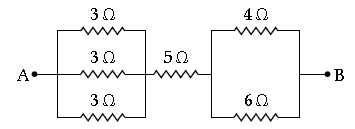
Answer:

Question: Calculate the equivalent resistance between the picture A and B in the following combination of
resistors .
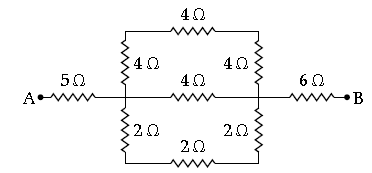
Answer: The three resistors each of 4 Ω are in series.
∴ R1 = 4 + 4 + 4 = 12 Ω.
The three resistors 2 Ω are in series.
∴ R2 = 2 + 2 + 2 = 6 Ω.

⇒ R3 = 2 Ω.
The resistors R1, R2 and R3 are in series.
∴ Req = R1 + R2 + R3
⇒ Req = 5 + 2 + 6 = 13 Ω
Question: Calculate the equivalent resistance between P and Q from the following diagram.

Answer: The two resistances 10 Ω are in series
R = 10 + 10 = 20 Ω
The resistances 5 Ω and R are in parallel.

⇒ R1 = 4 Ω
The resistances R1 3 Ω and 2 Ω are in series
∴ Equivalent resistance
Req= 3 + 4 + 2 =9 Ω
Question: Calculate the equivalent resistance between A and B from the following diagram.
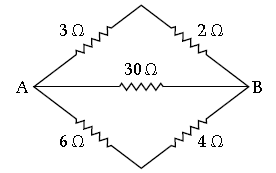
Answer: Resistances 3 Ω and 2 Ω are in series
∴ R1 = 3 + 2 = 5 Ω
Also resistances 6 Ω and 4 Ω are in series.
∴ R2= 6 + 4 = 10 Ω
Equivalent resistance between A and B is

Question: Six resistances are connected together as shown in the figure. Calculate the equivalent resistance
between the points A and B.
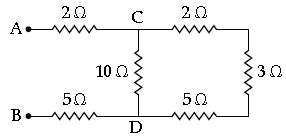
Answer: Resistance between the points C and D,
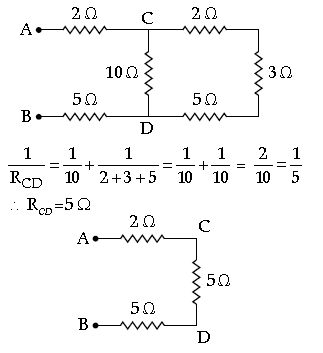
Question: The equivalent resistance of the following circuit diagram is 4 Ω . Calculate the value of x

Answer:

⇒ 5 + x = 6 ⇒ x = 6 – 5
⇒ x = 1 Ω
Question: (i) Sketch a graph to show the change in potential difference across the ends of an ohmic resistor and the current flowing in it. Label the axes of your graph
(ii) What does the slope of the graph represent?
Answer:

(ii) The slope of the graph represents resistance of the resistor.
Question: Mention two factors on which the resistance of a wire depends.
Answer: The resistance of the wire depends on the following factors
(i) Length of the wire.
(ii) Area of the cross-section of the wire.
Question: A wire of uniform thickness with a resistance of 27 Ω is cut into three equal pieces and they are joined in parallel. Find the resistance of the parallel combination.
Answer: Given, resistance of given wire = 27 Ω Resistance of small wire
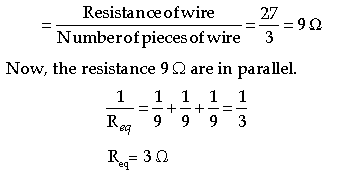
Question: Four resistances of 2.0 Ω each are joined end to end, to form a square ABCD. Calculate the equivalent resistance of the combination between any two adjacent corners.
Answer: Resistance between two adjacent corner A and B is

Question: Mention two factors on which the internal resistance of a cell depends.
Answer: The internal resistance of a cell depends on following factors
(i) Surface area of the electrode.
(ii) Concentration of the electrolyte.
Question: A cell of emf 1.5 V and internal resistance 10 Ω are connected to a resistor of 5 Ω with an ammeter in series (see figure). What is the reading of the ammeter?

Answer: Given, E = 1.5 V, r = 10 Ω R = 5 Ω, I = ?
We know that
E = I(R + r)
I = E / R+r = 1.5 / 10+5 = 1.5 / 15 = 0.1 A
Question: Calculate the resistance of 1 km long copper wire of radius 1 mm.
(Resistivity of copper is 1.72 × 10-8 Ω m).
Answer: Given, l = 1 km = 1000 m, r = 1 mm = 10–3 m,
a = πr2 = 3.14 × (10–3)2 = 3.14 × 10–6 m2,
Resistivity ρ = 1.72 × 10-8 Ω m

Question: Three resistors of 2 Ω, 3 Ω and 4 Ω are connected in (a) series, (b) parallel. Find the equivalent
resistance in each case.
Answer: Given, R1 = 2 Ω, R2 = 3 Ω, R3 = 4 Ω,
(a) In series, the equivalent resistance is
RS = R1 + R2 + R3
= 2 + 3 + 4 = 9 Ω
(b) In parallel if the equivalent resistance is Rp then
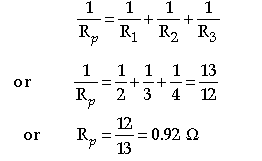
Question: A circuit is made by connecting a cell of emf E and internal resistance r across an external resistor R.
find an expression for the current I in the circuit.
Answer: We have
E = V + Ir
V = IR
E = IR + Ir = I (R + r)
I = E / (R + r)

Question:: Find the equivalent resistance of the following network between A & B.

Answer: Simplified diagram of the given network is

1 / R = 1 / 9 + 1 / 9 + 1 / 9
⇒ 1 / R = 3 / 9
⇒ R = 3 Ω
Question: How many protons will constitute a charge of 1 C?
Answer: We know that
Q = ne
where, Q = 1 C
e = 1.6 × 10-19 (change on proton)

Question: What does the slope of V – I graph represents?
Answer: If we plot V on Y axis and I on X axis the slope V/I represents the resistance of that circuit.
Question: Find the equivalent resistance of the given network between P & Q

Answer: The simplified circuit can be redrawn as
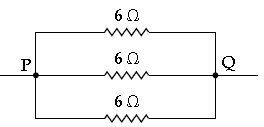
All the three resistors are in parallel
1 / R = 1 / 6 + 1 / 6 + 1 / 6
1 / R = 3 / 6
⇒ R = 2 Ω
Question: In the given circuit, find the potential drop on 3 Ω resistor

Answer: Total resistance of the circuit = 3 + 6 = 9 Ω
E.M.F. = 15 V
current, I = 15 / 9 = 5 / 3 ampere
Potential drop on 3 Ω resistor
V IR
= 5 / 3 X 3 volts
= 5 volts
Question: Find the current through the 3 Ω resistor

Answer: Let the current through 3 Ω resistor be I
∴ the current through 6 Ω resistor will be (9– I)
Since 3 Ω and 6 Ω resistor are in parallel combination, the potential drop across each will be same
⇒ 3 × I = 6(9–I)
⇒ 3I = 54 – 6I
⇒ 9I = 54
⇒ I = 6 ampere
Short Answer Type Questions II
Question: Find the equivalent resistance between points A and B.

Answer: 1 / R = 1 / R1 + 1 / R2 + 1 / R3
= 1 / 12 + 1 / 6 + 1 / 4
= 6 / 12
= 1 / 2
R = 2.Answer: 1 / R = 1 / R1 + 1 / R2 + 1 / R3
= 1 / 12 + 1 / 6 + 1 / 4
= 6 / 12
= 1 / 2
R = 2.Ω
Question: The relationship between the potential difference and the current in a conductor is stated in the form
of a law.
(i) Name the law.
(ii) What does the slope of V – I graph for a conductor represent?
(iii) Name the material used for making the connecting wire.
Answer: (i) Ohm’s law
(ii) Resistance of the conductor
(iii) Copper/ Aluminium.
Question: (i) What is an ohmic resistor?
(ii) Two copper wires are of the same length, but one is thicker than the other
(a) Which wire will have more resistance?
(b) Which wire will have more specific resistance?
Answer: (i) Ohmic resistor : The conductor which obeys Ohm’s law is called ohmic resistor or linear resistance. e.g., Silver, aluminium, copper, nichrome, etc.
(ii) (a) Thin wires will have more resistance, because the resistance of the wire varies inversely to the area of
the wire i.e.,
R = 1 / 1
(b) Thick wire will have more specific
resistance. Because p = RA / l
Question:
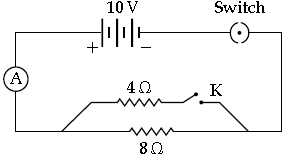
Calculate the reading of A when
(i) K is closed.
(ii) K is open.
Answer: (i) Let the resistance of 4 Ω and 8 Ω in parallel be R
∴ 1/R = 1/4 × 1/8
⇒ 1/R = 2 × 1/8 = 3/8
⇒ R = 8/3
Given V = 10 V
∴ I = V/R = 10 × 3/8
= 30/8 = 15/4 Amp
(ii) When K is open R’ = 8 Ω
∴ I = 10/8 = 5/4 Amp
Question: (i) State Ohm’s law
(ii) A metal wire of resistance 6 Ω is stretched so that its length increased to twice of original length. Calculate its new resistance
Answer: (i) Ohm’s law states that the current flowing through a conductor is directly proportional to the
potential difference across its ends provided that the physical conditions and the temperature of the
conductor remains constant.
(ii) Given : R1 = 6 Ω, l1 = l
l2 = 2l1 = 2l, R2 = ?

The volume of metal wire remains same.
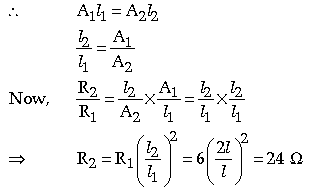
Question: (i) Draw a graph of potential difference (V) versus current (I) for an ohmic resistor.
(ii) How can you find the resistance of the resistor from this graph?
(iii) What is a non-ohmic resistor?
Answer: (i) The graph of potential difference (V) and current
(I) for ohmic resistance is shown below.

(ii) The resistance of the resistor is given by the slope of the straight line in the V – I graph.
(iii) Non-ohmic resistor : The conductor which does not obey Ohm’s law is known as nonohmic resistor.
Question: (i) A substance has nearly zero resistance at a temperature of 1 K. What is such a substance called?
(ii) State any two factors which affect the resistance of a metallic wire.
Answer: (i) The substance which has nearly zero resistance at a temperature of 1 K is called as superconductor.
(ii) The two factors which affect the resistance of a metallic wire are
(a) Length of the wire (l) i.e., R ∝ l.
(b) Area of cross-section (A) i.e., R = 1 / A
Question: Six resistances are connected together as shown in the figure. Calculate the equivalent resistance
between the points A and B.
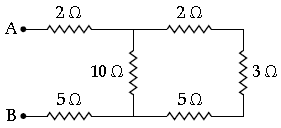
Answer: Equivalent resistance of 2 Ω, 3 Ω and 5 Ω in series is (2 + 3 + 5) Ω = 10 Ω. This 10 Ω resistance is in
parallel with another 10 Ω resistor
⇒ 1 / r = 1 / 10 + 1 / 10
⇒ 1 / r = 2 / 10
⇒ r = 5 Ω
Now, 2 Ω, 5 Ω, and 5 Ω resistors are in series.
∴ Equivalent resistance between A & B is
(2 + 5 + 5) Ω = 12 Ω
Question: The equivalent resistance of the following circuit diagram is 4 Ω. Calculate the value of x.

Answer: Resistance in upper branch = (5 + x) Ω Resistance in lower branch (8 +4) Ω = 12 Ω Both branches are in parallel and equivalent resistance is 4 Ω
⇒ 1 / 4 = 1 / 5 + x + 1 / 12
⇒ 1 / 5 + x = 1 / 4 – 1 / 12
= 3 – 1 / 12
Question: (i) State Ohm’s law
(ii) Diagrammatically illustrate how you would connect a key, a battery, a voltmeter, an
ammeter, an unknown resistance R and a rheostat so that it can be used to verify the above law.
Answer: (i) Ohm’s law – If all other physical conditions remaining same the current flown in a circuit is
directly proportional to the potential difference applied. Or V/I = constant.
(ii) To illustrate the Ohm’s law we draw the following circuit as
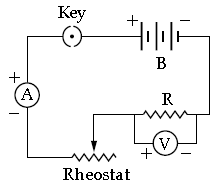
where, B is battery, V is voltmeter and A is ammeter.
Question: Three resistances of 6.0 Ω, 2.0 Ω and 4.0 Ω respectively are joined together as shown in the figure. The resistance are connected to an ammeter and to a cell of emf 6.0 V.

Calculate
(i) The effective resistance of the circuit
(ii) The current drawn from the cell
Answer: Rg = R1 + R2 = 2 + 4 = 6 Ω

Question: The V – I graph for a series combination and for a parallel combination of two resistors is shown in the figure.

Which of the two A and B represent the parallel combination? Give a reason for your answer.
Answer: Line A represents parallel combination because the resultant resistance in parallel combination is less
than that in series combination. So, lower in the slope lesser is the resistance.
Q. 13. Give the statements of Ohm’s Law and list the factors on which the resistance of a conductor, depends.
Answer: According to Ohm’s Law : The current flowing through a given conductor is directly proportional to the potential difference across its ends, provided the physical conditions of the conductor remain unaltered. The factors that can affect the resistance of a
conductor are :
(i) The nature of the material of which it is made.
(ii) The length of the conductor.
(iii) The area of cross-section of the conductor.
(iv) The temperature of the conductor.
Question: A set of 5 resistors of the given values, is arranged as shown. Find their equivalent resistance between the points (i) P, Q and (ii) R,S.

Answer: For the points P and Q, the equivalent circuit is shown in following figure :
∴ 1 / RPQ = 1 / 2 + 1 / 2 = 1 + 1 / 2 = 2 / 2 = 1
Or RPQ = 1 Ω
For the points R and S, the equivalent circuit is shown in figures (a) and (b).

Question: A battery, having an emf of 6 V and internal resistance r, (2/3) Ω, is connected to three resistors, arranged as shown. Calculate the total current drawn from the battery.

Answer: Let R be the equivalent resistance of the parallel combination of the resistors of 5 Ω and 10 Ω. Then,
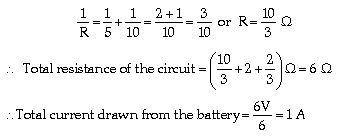
Question: A battery is designed by connecting four cells, each of emf 1.5 V and resistance 2.0 ohm in parallel. If this battery is now connected to an resistance of 2.5 ohm, find
(i) the total resistance of the circuit,
(ii) the current flowing in the external circuit and
(iii) the potential drop across the terminal of the cells.
Answer: The battery has a net emf of 1.5 V only and its net internal resistance is
1 / r = 1 / 2 + 1 / 2 1 / 2 + 1 / 2 + 4 / 2 = 2 or e = 0.5 ohm


When this battery is connected to an external resistance of 2.5 ohm, the
(i) total resistance (R) of the circuit is given by
R = 0.5 ohm + 2.5 ohm = 3.0 ohm
(ii) current flowing in the external circuit is
I = 1.5 = 1.5 / 3.0 = 0.5
(iii) for finding the p.d. across the terminals of cells, we notice that this will equal the p.d. across the external resistance connected to the battery. Hence (observed) p.d. across the battery = 0.5 × 2.5 Ω = 1.25 V
Question: Two resistors of 4 Ω and 6 Ω are connected in parallel. The combination is connected across a 6 V battery of negligible resistance. Calculate : (a) total resistance of circuit, (b) the current through the battery, (c) the current through each resistor. Draw a circuit diagram.
Answer: The circuit diagram is shown in figure

a) If the resistance of the parallel combination is Rp then

(b) Let the current through the battery be I, then
I = v / r = 6 / 2.4 = 2.5A
(c) The potential difference across each resistor is V = 6 volt (same as of the battery) since they are in parallel current through 4, Ω resistor
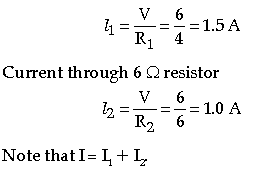
Question: In the diagram given below A, B and C are three ammeters each of negligible resistance. The ammeter B reads 0.5 A. Calculate :
(a) the reading of the ammeters A and C
(b) the total resistance of the circuit, and
(c) the e.m.f. of the cell
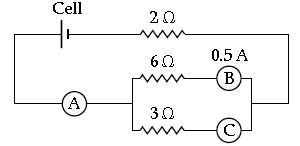
Answer: (a) Given, current in 6 Ω resistor I1 = 0.5 A (i.e., the reading of ammeter B)
∴ p.d. across 6 Ω resistor = 0.5 = × 6 = 3 V
The same will be the p.d. across the 3 Ω resistor connected in parallel with the 6 Ω resistor.
Therefore current in 3 Ω resistor is
I = 3v / 3Ω = 1A
Hence reading of ammeter C will be 1 A. The ammeter A will read the total current
I = I1 + I2 = 0.5 + 1 = 1.5 A
(b) If Rp is the equivalent resistance of resistors 6 Ω and 3 Ω connected in parallel, then
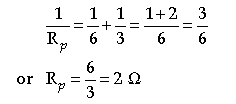
Now total resistance of circuit will be the equivalent resistance of series combination of resistors 2 Ω and
Rp (= 2 Ω) i.e.,
Total resistance R2 = 2 + 2 = 4 Ω
(c) e.m.f. of cell = Total current drawn × total resistance of circuit
= 1.5 × 4 = 6 V
Long Answer Type Questions
Question:. Three resistors are connected to a 6 V battery as shown in the figure

Calculate
(i) the equivalent resistance of the circuit
(ii) total current in the circuit.
(iii) potential difference across the 7.2 Ω resistor
Answer: (i) Resistance 8 Ω and 12 Ω are in parallel

Now, resistor R1 and 7.2 are in series
∴ Req= 4.8 + 7.2= 12 Ω
(ii) I = ?

(iii) Potential difference (PD) across 7.2 Ω resistor = 0.5 × 7.2 = 3.6 V
Question: The diagram shows an electrical circuit used for the verification of Ohm’s law. Label A, B, C, D and E. Draw a sketch to show how the value of current varies for different values of voltage across C.
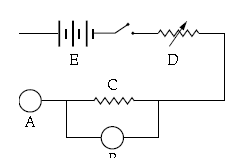
Answer:
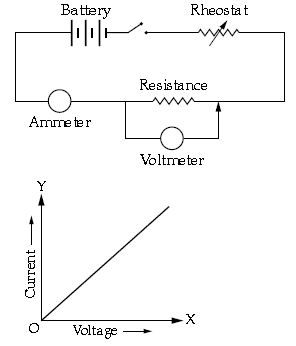
Question: A battery of e.m.f 12 V and internal resistance 2 Ω is connected with two resistors A and B of resistance 4 Ω and 6 Ω respectively joined in series
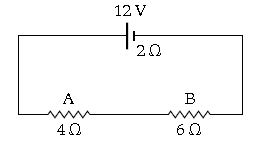
Find :
(i) Current in the circuit.
(ii) The terminal voltage of the cell
(iii) The potential difference across 6 Ω Resistor.
(iv) Electrical energy spent per minute in 4 Ω Resistor.
Answer: (i) R = R1 + R2
= 4 Ω + 6 Ω = 10 Ω
i = E / R + r
= 12 / (10 + 2)
= 1.0 A current in the circuit = 1.0 A
(ii) T.V. = IR
T.V. =1 × (6 +4)
T.V. =10 V
(iii) V = IR
=1 × 6
= 6.0 V
(iv) W = I2 R t
= 1 × 1 × 4 × 60 = 240 J
Question: A cell of e.m.f. 2 V and internal resistance 1.2 Ω is connected with an ammeter of resistance 0.8 Ω and two resistors of 4.5 Ω and 9 Ω as shown in the diagram below :

(i) What would be the reading on the Ammeter?
(ii) What is the potential difference across the terminals of the cell?
Answer:

Ammeter reading 0.4 A
(ii) V= E – ir
= 2 – 0.4 × 1.2
= 1.52 V
or V = iR
= 0.4 × (3 + 0.8)
= 1.52 V
Question: Three resistors are connected to a 12 V battery as shown in the figure given here.
(i) What is the current through the 8 Ω resistor?
(ii) What is the potential difference across the parallel combination of 6 Ω and 12 Ω resistors?
(iii) What is the current through the 6 Ω resistor?

Answer: (i) Resistances 12 Ω and 6 Ω are parallel
Answer:

(ii) Potential difference (PD) across parallel combination of resistances 6 Ω and 12 Ω is,
V = 1 X R1
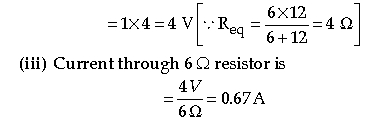
Question: Five resistors of different resistances are connected together a shown in the figure. A 12 V battery is
connected to the arrangement. Calculate :
(i) the total resistance in the circuit.
(ii) the total current flowing in the circuit.
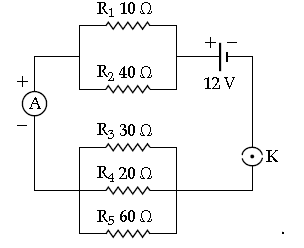
Answer:

Question: A cell of emf 1.5 V and internal resistance 1.0 Ω are connected to two resistors of 4.0 Ω and 20.0 Ω in
series as shown in the figure.

Calculate the
(i) Current in the circuit.
(ii) Potential difference across the 4.0 Ω resistor.
(iii) Voltage drop when current is flowing.
(iv) Potential differences across the cell.
Answer: Given, E= 1.5 V, r = 1 Ω
R1= 4 Ω, R2 = 20 Ω
R = R1+ R2 = 4 + 20 = 24 Ω

(ii) V= I R1 = 0.06 × 4 = 0.24 V
(iii) Voltage drop across internal resistance
Vr = 0.06 × 1 = 0.06 V
(iv) Terminal voltage V
= Potential difference across the cell
= E – Ir = 1.5 – 0.06 = 1.44 V
Question: In the figure below, the ammeter A reads 0.3 A.

Calculate
(i) The total resistance of the circuit.
(ii) The value of R.
(iii) the current flowing through R.
Answer:

(iii) V = IR
Since, potential at two ends are equal
So, I1R1 = I2R2
I1 × 30 = (0.3 – I1) × 60
I1 = 0.6 – 2 I1
I1 = 0.6 / 3 = 0.2 A
Question: In the figure given below A, B and C are three ammeters. The ammeter B reads 0.5 A (All the ammeters have negligible resistance).

Calculate :
(i) the readings in the ammeters A and C.
(ii) the resistance of the circuit.
Answer: (i) As 6 Ω and 3 Ω resistance are in parallel, so the potential difference across these resistances
will be same.
So, IB × 6 =IC × 3
⇒ 0.5 × 6 = IC× 3 ⇒ IC = 1.0 A
Reading of ammeter at C, IC = 1.0 A
Reading of ammeter at A
= IB + IC = 0.5 + 1.0 = 1.5 A
(ii) Total resistance of the circuit
R = 2 + 6X3 / 6+3
2 + 18 / 9 = 4Ω
Question: (i) Which of the two wires of similar dimensions, copper or nichrome, would you use for the electric heater element? Give reasons to justify your answer.
(ii) Two fuse wires of the same length are rated 5 A and 20 A. Which of the two fuse wires is thicker and why?
Answer: (i) Nichrome wire is used for electric heater, because it has high melting point and high resistivity.
(ii) A wire rate 20 A is thicker, because it carries large current and its cross-sectional area will be large.
Question: Define the emf (E) of a cell and the potential difference (V) across a resistor (R) in terms of the work done in moving a unit charge. State the relation between these two works and the work done in moving a unit charge through a cell connected across the resistor. Take the internal resistance of the cell as r. Hence, obtain expression for the current i in the circuit.
Answer: EMF of a cell is defined as the amount of work done in taking a unit positive charge around the complete circuit. Potential difference of a cell is defined as the amount of work done in carrying a unit positive charge in the circuit connected across the terminals of the cell. If W is the amount of work done in moving a test charge q between the terminals of a cell through a resistor R then potential difference V in the work done in moving a unit positive charge across the terminals of cells.
Question: A circuit is made from a combination of 4 cells, a resistor of 1.8 Ω an unknown resistor X and an
ammeter, all connected in series. Draw a diagram of this circuit. If the cells are of emf 1.5 V each and internal resistance 0.05 Ω each, find the total resistance of the circuit. If the ammeter reads 1 A, find the value of x and the p.d. across it.
Answer: The labelled diagram of the given circuit is as shown below
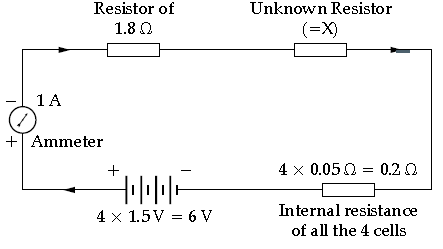
We have
(i) Total resistance = (1.8 + 0.2 + x) Ω = (2 +x) Ω
(ii) Total emf = 4 × 1.5 V = 6 V
Current = 6 (2+X) = 1 A(given)
This gives X = 4 Ω
Hence total resistance = (2 + x) Ω = (2 + 4) Ω = 6 Ω
(iii) The p.d. across X = (1 A × 4 Ω) = 4 V
Question: An electrical circuit was set up as shown. Find the current flowing through each of the resistances in
the circuit.

Answer: The 3 Ω and 2 Ω resistors are in parallel. If R be their equivalent resistance, then

Current through the 0.3 Ω resistor = 1.33 A This is also the total current flowing through the parallel combination of the 2 Ω and the
3 Ω resistors. It will be divided in the ratio
3 : 2 in the two resistors (of 2 Ω and 3 Ω). Thus we have
Current throughthe 2 Ω resistor = 3 / 5 X 4 / 3 A = 4 / 5 A = 0.8 A
Current throughthe 3 Ω resistor = 2 / 5 X 4 / 3 A = 8 / 15 A = 0.55 A
Question: A circuit is made out of a battery (of emf 9 V and internal resistance 0.6 Ω) connected to three resistors
A, B and C

(i) What is the combined resistance of B and C?
(ii) What is the total resistance of A, B and C?
(iii) What is the total resistance of the circuit?
(iv) Find the current flowing in each of the three resistors A, B and C.
Answer: (i) Let R be the combined resistance of B and C. Then we have

(ii) The total resistance, say x of A, B and C is given by,
X = A + R = (2 + 2.4) Ω = 4.4 Ω
(iii) The total resistance, say Z of the circuit is given by,
Z = (x + 0.6) Ω = (4.4 + 0.6) Ω = 5.0 Ω
(iv) The current flowing in the circuit is,I
= 9 / Z = 9 / 5 A = 1.8 A
This is also the current flowing through the resistance A. Thus, IA = 1.8 A.
Let IB and IC be the currents through the resistors B and C. We then have IB+ IC = 1.8

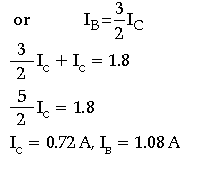
Electric Power and Energy, Fuse, Household Circuit
Short Answer type Questions I
Question: An electric bulbs of resistance 500 Ω draws a current of 0.4 A. Calculate the power of the bulb and the
potential difference at its ends.
Answer: Given, R = 500 Ω
I = 0.4 A
P = I2R
= (0.4) × 500
= 80 Watts
Also, V = IR
= 0.4 × 500
= 200 volts
Question: Name the material used for :
(i) Electric fuse.
(ii) Connecting wire.
(iii) Filament of an electric bulb.
(iii) Heating element of an electric toaster.
Answer: Material used for making
(i) Electric fuse – Alloy of lead and tin
(ii) Connecting wire – Copper
(iii) Filament of electric bulb – Tungsten filament
(iv) Heating element of an electric toaster – Nichrome wire
Question: Calculate the quantity of heat produced in a 20 Ω resistor carrying 2.5 A current in 5 minutes.
Answer: H= i2Rt
= 2.5 × 2.5 × 20 × 300
= 37500 J
Question: State the characteristics required in a material to be used as on effective fuse wire.
Answer: High resistance Low melting point
Question: (i) Name the device used to protect the electric circuit from overloading and short circuits.
(ii) On what effect of electricity does the above device work?
Answer: (i) Electric fuse is used to protect the electric circuit from overloading and short circuits.
(ii) Heating effect of electric current.
Question: An electrical appliance is used at 1000 kVA, 220 V. If the appliance is operated for 2 h, calculate the
energy consumed by the appliance in (iv) (i) kWh (ii) joule
Answer: Given, P = 1000 kVA = 1000 kW, t = 2 h
(i) Energy consumed in kWh is E = P × I = 1000 × 2 = 2000 kWh
(ii) Energy consumed in joule is E = 2000 × 3.6 × 106 J = 7.2 × 102 J
Question: Two bulbs are marked 100 W, 220 V and 60 W, 110 V. Calculate the ratio of their resistances.
Answer: P1 = 100 W, P2 = 60 W, V1 = 220 V

Question: (i) What is the colour code for the insulation on the earth wire?
(ii) Write an expression for calculating electrical power in terms of current and resistance
Answer: (i) The colour code for the insulation on the earth wire is green or yellow.
(ii) The expression for calculating electrical power
(P) in terms of current (I) and resistance (R) is given by P = I2 R.
Question: (i) Which part of an electrical appliance is earthed?
(ii) State a relation between electrical power, resistance and potential difference in an electrical circuit.
Answer: (i) Metallic body of an electrical appliance is earthed.
(ii) The relation between electrical power, resistance and potential difference in a circuit is
given by P = V2 / R
Question: (i) Give two characteristic properties of copper wire which make it unsuitable for use as fuse wire.
(ii) Name the material which is used as a fuse wire
Answer: (i) The two characteristic properties of copper wire are as
(a) It should be of low melting point and high resistivity
(b) It should be good conductor of electricity.
(ii) The alloy of tin and lead is used as fuse wire.
Question: An electric heater is rated 1000 W – 200 V. Calculate
(i) the resistance of the heating element.
(ii) the current flowing though it.
Answer: Given, P = 1000 W, V = 200 V

Question: An electrical heater is rated 4 kW, 220 V. Find the cost of using this heater for 12 h, if one kWh of
electrical energy cost 3.25.
Answer: Given, P = 4 kW, V = 220 V, t = 12 h E = P × t = 4 × 12 = 48 kWh Cost of energy consumed
= 48 × 3.25 = 156
Question: How does the heat produced in a wire or a conductor depend upon the
(i) current passing through the conductor?
(ii) resistance of the conductor?
Answer: (i) Heat produced in a wire is directly proportional to the square of the current (I2) flowing through the conductor.
(ii) Heat produced in a wire is directly proportional to the resistance (R) of the conductor .
Question: The electrical gadgets used in a house such as bulbs, fans, heater, etc., are always connected in parallel, not in series. Give two reasons for connecting them in parallel.
Answer: The electrical gadgets are always connected in parallel, because of the following reasons :
(i) Each appliance works at the same voltage.
(ii) If one appliance stop working, the other appliance continue to work.
Question: What is meant by earthing of an electrical appliance? Why is it essential?
Answer: Earthing of an electrical appliance is a process in which appliance is connected to thick copper wire, which is buried deep in the earth and its ends are connected to a copper plate surrounded by a mixture of charcoal and salt. If the live wire touches the metal body, it prevents the person touching the appliance from electric shock.
Question: Of the three connecting wires in a household circuit
(i) Which two of the three wires are at the same potential
(ii) In which of the three wires should the switch be connected?
Answer: (i) Neutral and the earth wire are at the same potential, because the earth wire and electrical
wire are connected together.
(ii) Switch should be connected in live wire.
Question: Draw a labelled diagram of a three pin socket.
Answer: The three pins socket diagram is shown below
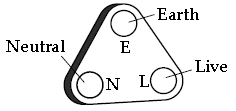
Question: State the purpose of a fuse in an electric circuit. Name the material used for making a fuse wire.
Answer: The purpose of a fuse in an electric circuit is to safeguard the circuit from an excessive flow of
current in the circuit. The alloy of lead and tin is used for making a wire.
Question: An electric kettle is rated 2.5 kW, 250 V. Find the cost of running the kettle for two hours at 60 paise
per unit.
Answer: Given, power P = 2.5 kW
Voltage V = 250 V
Rate per unit = 60 paisa = 0.60 Time t = 2 h Energy E = P × t = 2.5 × 2 = 5 kWh ∴ cost of energy consumed = 5 × 0.6 = 3.00
Question: A geyser has a label 2 kW, 240 V. What is the cost of using it for 30 min, if the cost of electricity is ` 3
per commercial unit?
Answer: Given, P = 2 kW, V = 240 V
t = 30 min = 30 / 60 = 0.5 h
Rate = Rs. 3/ unit, Cost = ?
Energy E = P × t = 2 × 0.5 = 1 kWh
Cost of energy consumed = 1 × 3 = ` 3
Question: Explain briefly the function of the following in the household wiring
(i) a three-pin plug.
(ii) main switch
Answer: (i) In three-pin plug, the left pin has live wire, the right pin has material wire and the longer and
thicker pin has earthing wire. All the pins have split ends to provide spring action.
(ii) It is used to switch OFF or ON the main current supply.
Question: Draw the diagram of the ring main circuit
Answer: The diagram is shown below

Question: How does earthing prevent electrical shock?
Answer: In case when live wire touches the metallic body of appliance, the earth wire provides an alternate
path for the current to flow, thus preventing the person from heavy shock.
Question: A family uses a light bulb of 100 W, a fan of 100 W, and a heater of 1000 W, each for 8 h a day. If
the cost of electricity is 2 per unit, what is the expenditure for the family per day on electricity?
Answer: Given, Pb = 100 W, Pf = 100 W, Ph = 1000 W, T = 8 h (each), rate = 2/unit
P = Pb + Pf + Ph = 100 + 100 + 1000
= 1200 W = 1.2 kW
E = P × t = 1.2 × 8 = 9.6 kWh
Cost of energy consumed per day = 9.6 × 2
= ` 19.20
Question: Calculate the electrical energy in SI units consumed by a 100 W bulb and a 60 W fan connected in parallel for 5 min.
Answer: Given, Pb = 100 W, Pf = 100 W

Question: In a three-pin plug, why is the earth pin made longer and thicker than other two pins?
Answer: The earth pin is made longer and thicker, because of the following :
(i) It cannot enter live (L) or (N) socket.
(ii) To avoid from confusion between the earth pin and other two pins.
Question: An electric kettle is rated at 230 V, 1000 W.
(a) What is the resistance of its element when in use?
(b) What is the safe value of current that can pass through its element?
Answer: Given, P = 1000 W. V = 230 volt

Short Answer Type Questions II
Question: (i) Name the colour code of the wire which is connected in the metallic body of an appliance.
(ii) Draw the diagram of a duel control switch when the appliance is switched ‘ON’.
Answer:

Question: In Mrs. Pinto’s flat there are 6 bulbs of 100 W each, a heater of 2 kW and 5 fans of 50 W each. If these
are used everyday as shown below, calculate the cost of energy consumption for a month of 30 days at the rate of Rs. 3.3\50 per kW h. 6 bulbs of 100 W each used 8 h per day 1 heater of 2 kW used half hour daily
5 fans of 50 W each are used 6 h everyday.
Answer:. Electrical energy consumed by bulbs in one month = (6 × 100 W) × (8h × 30)/100 kWh = 144 kWh
Electrical energy consumed by heater in one month = 2 kW × 1/2 h × 30 = 30 kWh
Electrical energy consumed by fans in one month = (5 × 50 W) × (6h × 30)/1000 kWh = 219 kWh
Cost of electricity = 219 × 3.50 = 766.50
Question: (i) Which particles are responsible for current in conductors?
(ii) To which wire of a cable in a power circuit should the metal case of a geyser be connected?
(iii) To which wire should the fuse be connected?
Answer: (i) Electrons
(ii) Earth wire
(iii) Live wire
Question: (i) Two sets A and B of three bulbs each, are glowing in two separate rooms. When one of the bulbs in set A is fused, the other two bulbs also cease to glow. But in set B, when one bulb fuses, the other two bulbs continue to glow. Explain why this phenomenon occurs?
(ii) Why do we prefer arrangements of set B for house circuit ?
Answer: (i) The bulbs of set A are connected in series. Therefore, when one bulb is fused the current stop flowing.
Whereas, the bulbs of set B are connected in parallel. When one bulb fuse, then current flows through the other bulbs.
(ii) We prefer arrangement of set B for house circuiting, because the potential difference in it is same.
Question: (i) An electrical gadget can give an electric shock to its user under certain circumstance. Mention any two of these circumstances.
(ii) What preventive measure provided in a gadget can protect a person from an electric shock?
Answer: (i) The two circumstances, which give electric shock are as
(a) An electric shock may be caused due to poor insulation of wires.
(b) When wires of electric appliances are touched with wet hands.
(ii) To prevent from electric shocks, the insulation of wires must be of good quality and it should be checked from time to time particularly when they become old.
Question: (i) A cell is sending current in an external circuit. How does the terminal voltage compare with the emf of the cell?
(ii) What is the purpose of using a fuse in an electrical circuit?
(iii) What are the characteristic properties of fuse wire?
Answer: (i) Terminal voltage is less than that of emf of the cell.
(ii) The purpose of using a fuse in an electrical circuit is to limit the electric current in an electric circuit when there is overheating or overloading in the circuit. A fuse is used as safety device.
(iii) The characteristic properties of fuse wire are low melting point and high resistance.
Question: (i) Write an expression for the electrical energy spent in the flow of current though an electrical appliance in terms of I, R and t.
(ii) At what voltage is the alternating current supplied to our houses?
(iii) How should the electric lamps in a building be connected?
Answer: (i) The expression for the electrical energy E = I2Rt
(ii) Alternating current supplied in our houses is at voltage 220 V.
(iii) The electric lamp in a building should be connected in parallel.
Question: (i) An electric bulb is marked 100 W, 250 V. What information does this convey?
(ii) How much current will the bulb draw, if connected to a 250 V supply?
Answer: (i) It conveys that when the bulb is lighted on 250 V supply, it consumed 100 W electrical power i.e.,
100 J of electrical energy is consumed in 1 s.
(ii) Current drawn I = P / v = 100 /250 = 0.4 A
Question: Calculate the quantity of heat that will be produced in a coil of resistance 75 Ω if a current of
2 A is passed through it for 2 min.
Answer: Given, R = 75 Ω, t = 2 min
= 2 × 60 = 120 s, I = 2 A
Heat produced H = ?
H = I2Rt = (2)2 × 75 × 120 = 36000 J.
Question: Find the cost of operating an electric toaster for two hours, if it draws 8 A current on a 110 V circuit.
The cost of electrical energy is 2.50 per kWh.
Answer: Given, t = 2 h, I = 8 A, V = 110 V Cost = 2.50/kWh

Cost of 1.76 kWh = 2.5 × 1.76 = 4.40
Question: An electrical appliance is rated 1500 W, 250 V. This appliance is connected to 250 V mains. Calculate (i) the current drawn. (ii) the electrical energy consumed in 60 h (iii) the cost of electrical energy consumed at 2.50 per kWh
Answer:
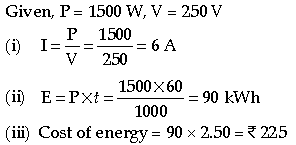
Question: Make a table with the names of three electrical appliances used in your home in one column,
their power, voltage rating and approximate time for which each one is used in one day in the other
columns.
Answer:

Question: A house has main fuse of 5 A rating. 5 bulbs each of 60 W and 2 tube lights each of 40 W are used
simultaneously.
(i) How much current is drawn from the mains of 220 V?
(ii) How many more bulbs each of 100 W can also be lighted on a festival day?
Answer: (i) Total power of appliances used simultaneously
P = (5 × 60) + (2 × 40) = 380 W
Voltage of mains V = 220 volt
Current drawn from the mains

(ii) Excess current available which can be safely
used = 5 A – 1.73 A = 3.27 A
Current drawn by each 100 W bulb at 220 V,

Number of 100 W bulbs which can be lighted on a festival day

i.e., 7 more bulbs can be lighted.
Question: An electric bulb rated 220 V, 60 W glows when connected with 220 V mains.
(i) Find the resistance of the filament of the bulb.
(ii) Another identical bulb is connected in series with the first one and the system is connected with the 220 V mains. Draw a diagram to show the arrangement and find : (a) the rate of consumption of energy in each bulb, and (b) total power consumed.
(iii) If two bulbs are connected in parallel draw a diagram of this arrangement. What will then be the total power consumed?
Answer: Given : rating of bulb is 220 V, 60 W i.e., voltage
V = 220 volt and power P = 60 watt.
(i) Resistance of filament of the bulb

(ii) The arrangement of two identical bulbs in series with the mains is shown in following figure.

In this arrangement voltage across each bulb will be V = 110 V
(a) Rate of consumption of energy in each bulb

Assuming that the resistance of bulb does not change.
(b) Total power consumed in the two bulbs
= 15 + 15 = 30 W
(iii) The arrangement of two identical bulbs in parallel with the mains is shown in following figure

In this arrangement, voltage across each bulb will be V = 220 volt and then power spent in each bulb will be 60 W.
∴ Total power consumed in the two bulbs
= 60 + 60 = 120 W
Question: Two resistors R1 and R2 of resistance 3 Ω and 6 Ω respectively are connected in parallel across a battery of p.d. 12 V. Draw the circuit diagram. Calculate the electrical energy consumed in 1 minute in each resistance.
Answer: The circuit diagram, is shown in following figure :
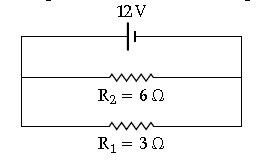
Given, R1 = 3 Ω, R2 = 6 Ω, V = 12 volt, t = 1 minute = 60 s The resistors R1 and R2 connected in parallel, so the
voltage V across each resistor is equal to 12 volt. Electrical energy spent in resistor R1,

Question: A 6 V, 12 W lamp is connected in series with a resistor R and a source of 12 supply.
(a) What is the purpose of the resistor R?
(b) Calculate the value of the resistor R for the proper working of the lamp.
(c) What is the current flowing through the circuit?
Answer: (a) The given lamp is meant to be used on 6 V supply since the source available is of 12 V, so a resistor R is used in series with the lamp to reduce the current to its safe value for the lamp.
(b) Maximum current which the lamp rated 6 V, 12 W can withstand, is

On connecting a resistor R in series with
the lamp, total resistance of circuit = R + R =
(R+3) Ω
With 12 V supply, the current in the current in the circuit should be equal to I = 2 A
By Ohm’s law, V = IR
∴ 12 = 2(R+3)
Or 12 = 2R + 6 or R = 3 Ω
(c) Current flowing through the circuit = 2 A
Question; Two coils of resistances R1 = 3 Ω and R2 = 6 Ω are connected in series across a battery of p.d. 12 V,
Draw the circuit diagram. Find (i) the electrical energy consumed in 1 minute in each resistance,
(ii) the total electrical energy supplied by the battery in 1 minute.
Answer:
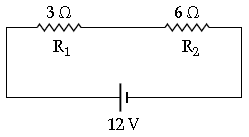
Given, R1 = 3 Ω, R2 = 6 Ω, V = 12 volt, t = 1 minute = 60 s
Total resistance of circuit, R = R1 + R2 = 3 + 6 = 9 Ω
Current in circuit I = V / R = 12 / 9 = 4 / 3 A
Since the resistances are in series, so same current flows in each resistance. Electrical energy consumed in R1 will be

(ii) Total electrical energy supplied by the battery in 1 minute
W = W1 + W2 = 320 + 640 = 960 J
Question: Two bulbs A and B are rated 100 W, 120 V and 10 W, 120 V respectively. They are connected across a
120 V source in series.
(a) Calculate the current through each bulb.
(b) Which bulb will consume more power?
Answer: (a) Resistance of bulb A (rating 100 W, 120 V ) is

When they are connected in series across a source of voltage V = 120 volt,
Total resistance RS = RA + RB
= 144 + 1440 = 1584 Ω
Current in circuit I = V / R = 120 / 1584 = 0.08 A
Same current (= 0.08 A) passes through each bulb.
(b) Power consumed in the bulb A is PA = I2RA
Power consumed in the bulb B is PB = I2RB
Since RA < RB ∴ PA < PB
Hence the bulb B (rated 10 W, 120 V) consumes more power than the bulb A (rated 100 W, 120 V) when they are connected in series .
Question: Two bulbs A and B are rated 100 W, 120 V and 10 W, 120 V respectively. They are connected in
parallel across a 120 V source.
(a) Find the current in each bulb.
(b) Which bulb will consume more power ?
Answer: (a) Resistance of bulb A (rating 100 W, 120 V) is

Rb = V2 / PB = (120)2 / 10 = 1330 Ω
As the bulbs are connected in parallel across a 120 V source, the voltage is the same (= 120 V) across each
bulb Current in the bulb A
IA = V / RA = 120 /144 = 0.84A
Current in the bulb B
Ib = V2 / RB = 120 / 1440 = 0.084 A
(b) Power consumed by the bulb A will be 100 W and by the bulb B will be 10 W as per their specifications since both the bulbs operate at their rated voltage (= 120 V). Obviously the bulb A (with rating 100 W, 120 V) consumes more power than the bulb B (with rating 10 W, 120 V).
Long Answer type Questions
Question: (i) Explain the meaning of the statement ‘current rating of a fuse is 5 A’.
(ii) In the transmission of power generated at the generating stations is steeped up from 11 kV to 132 kV before it is transmitted. Why?
Answer: (i) Current rating of a fuse is 5 A signifies that this fuse can allow a current of upto 5 A to pass
through into the circuit. If the current exceeds this limit it will blow out and thus breaking the circuit.
(ii) To minimize the power losses during transmission.
As power loss as heat P = I2R
Also I = P/V
If we increase V, I will decrease and hence power loss decreases.
Question: Two resistors of 4 Ω and 6 Ω are connected in parallel to a cell to draw 0.5 A current from the cell.
(i) Draw a labelled circuit diagram showing the above arrangement.
(ii) Calculate the current in each resistor.
Answer: (i) The circuit diagram is shown below
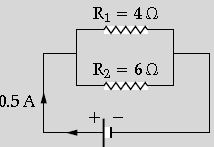
(ii) Let the current flowing through resistance R1 is I and current flowing through R2 resistance is 0.5 – I
∴ I × 4 = (0.5 – I) × 6
⇒ 4I = 3 – 6 I
⇒ 10I = 3
⇒ I = 0.3 A
∴ Current flowing through R1 is 4 Ω is 0.3 A and
current flowing though R2 = 6 Ω is
0.5 – 0.3 = 0.2 A
Question: The figure shows a circuit when the circuit is switched on, the ammeter reads 0.5 A.
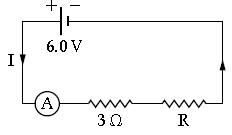
(i) Calculate the value of the unknown resistor R.
(ii) Calculate the charge passing through the 3 Ω resistor in 120 s.
(iii) Calculate the power distributed in the 3 Ω resistor

(ii) Q = I × t = 0.5 × 120 = 60 C
(iii) P = VI = I2 R = (0.5)2 × 3
= 0.25 × 3 = 0.75 W
Question: (i) Name two safety devices which are connected to the live wire of a household electrical circuit.
(ii) Give one important function of each of these two devices.
Answer: (i) The two safety devices which are connected to the live wire of a household electrical circuit are fuse and switch.
(ii) The important functions used are as :
(i) Fuse : It is used to limit the current in a circuit and safeguard the appliances.
(ii) Switch : It is used for switching ON or OFF the circuit.
Question: (i) In what unit does the domestic electric meter measures the electrical energy consumed?
State the value of unit in SI unit.
(ii) Why should switches always be connected to the live wire?
(iii) Give one precaution that should be taken while handling switches.
Answer: (i) The domestic electric meter measures electrical energy in kilowatt hour (kWh).
1 kilowatt-hour (1 kWh) = 1 kilowatt × 1 hour
= 1000 watt × 1 hour
= 1000 J s-1 × (60 × 60 s)
= 3.6 × 106 J
Thus, 1 kWh = 3.6 × 106 J
(ii) Switches should always be connected to the live wire, because on switching OFF, the live and neutral wires will be at the zero potential. On the other hand, if the switch is connected to the neutral wire, on switching OFF, the appliance remains connected to the live wire be at supply voltage.
(iii) Switches should not be touched with wet hands.
Question: (i) The diagram (a) and (b) given below are of a plug and a socket with arrow marked as 1, 2, 3 and 4, 5, 6 respectively on them. Identify and write live (L), neutral (N) and the earth (E) against the correct number.
(ii) Calculate the electrical energy consumed when a bulb of 40 W is used for 12.5 h every day for 30 days

(i) 1 – Earth (E)
2 – Neutral (N)
3 – Live (L)
4 – Earth (E)
5 – Neutral (N)
6 – Live (L)
(ii) Given, P = 40 W, t = 12.5 h
Number of days = 30
Electrical energy E = ?
E = P × t × number of days
= 40 / 1000 X 12.5 X 30 = 1.5 KWh
Question: With reference to the diagram given below,
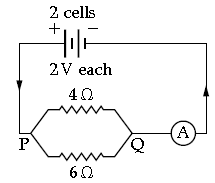
Calculate
(i) The equivalent resistance between P and Q.
(ii) The reading of the ammeter.
(iii) The electrical power between P and Q.
Answer:

(iii) Power, P = I2Req = (1.67)2 × 2.4 = 6.67 W
Question: An electric bulb rated 220 V, 60 W is working at full efficiency.

(i) State the resistance of the coil of the bulb.
(ii) Another identical bulb is connected in series with the first one and the system is connected across the mains as shown alongside.
(a) State the rate of conversion of energy in each bulb.
(b) Calculate the total power.
(c) What will be the power, if the bulbs are connected in parallel?
Answer: (i) V = 220 V, P = 60 W

(ii) When another identical bulb is connected in series. Then,
(a) Energy conversion in each bulb
Total resistance = 806.7 + 806.7
Rtotal = 1613.4 Ω
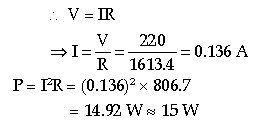
(b) Total power (in series) = 2 × 15 watts = 30 watts
(c) Total power (in parallel)) = 60 W + 60 W = 120 W
Question: A bulb is marked 100 W, 220 V and an electric heater is marked 2000 W, 220 V.
(i) What is the ratio between the resistance of these two devices?
(ii) How does the power voltage rating of a device help us to decide about the type of loads
(connecting wires) to be used for it?
(iii) In which of the two devices, a thicker connecting wire or load is required?
Answer: Given, P1= 100 W, V1 = 220 V
P2 = 2000 W, V2 = 220 V

A wire having current 9.1 A is required for a heater.
(iii) The current flowing through the bulb is only 0.45 A while through heater is 9.1 A. Hence, a heavy load is needed for the heater while for a bulb an ordinary thin connecting wire is required.
Question: Four cells, each of emf 1.5 V and internal resistance 2.0 Ω are connected in a parallel. The battery of the cells is connected to an external resistance of 2.5 Ω. Calculate :
(i) the total resistance of the circuit.
(ii) the current flowing in the external circuit.
(iii) the drop in potential across the terminals of the cells.
Answer: Given, Number of cells n = 4, Emf of each cell, E =
1.5 V, r = 2.0 Ω, R = 2.5 Ω
(i) Total internal resistance of cells

Question: An electric iron is rated ‘220 V, 1 kW’. Under normal working conditions, find :
(i) the resistance of the heating element in the iron.
(ii) the amount of current that will flow through the element.
(iii) the amount of heat that will produced in 5 minutes.
(iv) if the line voltage falls to 180 V, the power consumed.
Answer: Given, V = 220 volt, and P = 1 kW = 1000 W
(i) since P = V2 / R
Resistance of the heating element
R = V2 / P = (220)2 / 1000 = 49.4
Current through the element
I = P / V = 1000 / 220 = 4.54 A
(iii) Heat produced in time t (= 5 min or 300 s )
= Power × time
= 1000 × 300
= 300000 J = 300 kJ
If the line voltage falls to 180 V, power consumed is given by
P = V2 / R = (180)2 / 48.4 = 675 W
Here we have assumed that the resistance of the element does not change on fall of voltage.



